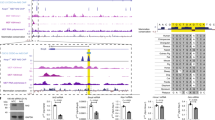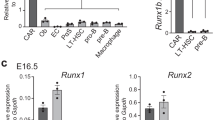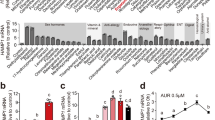Abstract
Hepcidin is a key regulator of systemic iron homeostasis. Hepcidin deficiency induces iron overload, whereas hepcidin excess induces anemia. Mutations in the gene encoding hemojuvelin (HFE2, also known as HJV) cause severe iron overload and correlate with low hepcidin levels, suggesting that hemojuvelin positively regulates hepcidin expression. Hemojuvelin is a member of the repulsive guidance molecule (RGM) family, which also includes the bone morphogenetic protein (BMP) coreceptors RGMA and DRAGON (RGMB). Here, we report that hemojuvelin is a BMP coreceptor and that hemojuvelin mutants associated with hemochromatosis have impaired BMP signaling ability. Furthermore, BMP upregulates hepatocyte hepcidin expression, a process enhanced by hemojuvelin and blunted in Hfe2−/− hepatocytes. Our data suggest a mechanism by which HFE2 mutations cause hemochromatosis: hemojuvelin dysfunction decreases BMP signaling, thereby lowering hepcidin expression.
This is a preview of subscription content, access via your institution
Access options
Subscribe to this journal
Receive 12 print issues and online access
$209.00 per year
only $17.42 per issue
Buy this article
- Purchase on Springer Link
- Instant access to full article PDF
Prices may be subject to local taxes which are calculated during checkout








Similar content being viewed by others
References
Hentze, M.W., Muckenthaler, M.U. & Andrews, N.C. Balancing acts: molecular control of mammalian iron metabolism. Cell 117, 285–297 (2004).
Krause, A. et al. LEAP-1, a novel highly disulfide-bonded human peptide, exhibits antimicrobial activity. FEBS Lett. 480, 147–150 (2000).
Park, C.H., Valore, E.V., Waring, A.J. & Ganz, T. Hepcidin, a urinary antimicrobial peptide synthesized in the liver. J. Biol. Chem. 276, 7806–7810 (2001).
Pigeon, C. et al. A new mouse liver-specific gene, encoding a protein homologous to human antimicrobial peptide hepcidin, is overexpressed during iron overload. J. Biol. Chem. 276, 7811–7819 (2001).
Nemeth, E. et al. Hepcidin regulates cellular iron efflux by binding to ferroportin and inducing its internalization. Science 306, 2090–2093 (2004).
Nicolas, G. et al. Lack of hepcidin gene expression and severe tissue iron overload in upstream stimulatory factor 2 (USF2) knockout mice. Proc. Natl. Acad. Sci. USA 98, 8780–8785 (2001).
Roetto, A. et al. Mutant antimicrobial peptide hepcidin is associated with severe juvenile hemochromatosis. Nat. Genet. 33, 21–22 (2003).
Nicolas, G. et al. The gene encoding the iron regulatory peptide hepcidin is regulated by anemia, hypoxia, and inflammation. J. Clin. Invest. 110, 1037–1044 (2002).
Lee, P., Peng, H., Gelbart, T., Wang, L. & Beutler, E. Regulation of hepcidin transcription by interleukin-1 and interleukin-6. Proc. Natl. Acad. Sci. USA 102, 1906–1910 (2005).
Nemeth, E. et al. Hepcidin, a putative mediator of anemia of inflammation, is a type II acute-phase protein. Blood 101, 2461–2463 (2003).
Nemeth, E. et al. IL-6 mediates hypoferremia of inflammation by inducing the synthesis of the iron regulatory hormone hepcidin. J. Clin. Invest. 113, 1271–1276 (2004).
Papanikolaou, G. et al. Mutations in HFE2 cause iron overload in chromosome 1q- linked juvenile hemochromatosis. Nat. Genet. 36, 77–82 (2004).
Lanzara, C. et al. Spectrum of hemojuvelin gene mutations in 1q-linked juvenile hemochromatosis. Blood 103, 4317–4321 (2004).
Lee, P.L., Beutler, E., Rao, S.V. & Barton, J.C. Genetic abnormalities and juvenile hemochromatosis: mutations of the HJV gene encoding hemojuvelin. Blood 103, 4669–4671 (2004).
Huang, F.W., Rubio-Aliaga, I., Kushner, J.P., Andrews, N.C. & Fleming, M.D. Identification of a novel mutation (C321X) in HJV. Blood 104, 2176–2177 (2004).
Samad, T.A. et al. DRAGON: a member of the repulsive guidance molecule-related family of neuronal- and muscle-expressed membrane proteins is regulated by DRG11 and has neuronal adhesive properties. J. Neurosci. 24, 2027–2036 (2004).
Niederkofler, V., Salie, R., Sigrist, M. & Arber, S. Repulsive guidance molecule (RGM) gene function is required for neural tube closure but not retinal topography in the mouse visual system. J. Neurosci. 24, 808–818 (2004).
Rodriguez Martinez, A., Niemela, O. & Parkkila, S. Hepatic and extrahepatic expression of the new iron regulatory protein hemojuvelin. Haematologica 89, 1441–1445 (2004).
Huang, F.W., Pinkus, J.L., Pinkus, G.S., Fleming, M.D. & Andrews, N.C. A mouse model of juvenile hemochromatosis. J. Clin. Invest. 115, 2187–2191 (2005).
Niederkofler, V., Salie, R. & Arber, S. Hemojuvelin is essential for dietary iron sensing, and its mutation leads to severe iron overload. J. Clin. Invest. 115, 2180–2186 (2005).
Lin, L., Goldberg, Y.P. & Ganz, T. Competitive regulation of hepcidin mRNA by soluble and cell-associated hemojuvelin. Blood 106, 2884–2889 (2005).
Monnier, P.P. et al. RGM is a repulsive guidance molecule for retinal axons. Nature 419, 392–395 (2002).
Zhang, A.S., West, A.P. Jr, Wyman, A.E., Bjorkman, P.J. & Enns, C.A. Interaction of hemojuvelin with neogenin results in iron accumulation in human embryonic kidney 293 cells. J. Biol. Chem. 280, 33885–33894 (2005).
Samad, T.A. et al. DRAGON, a bone morphogenetic protein co-receptor. J. Biol. Chem. 280, 14122–14129 (2005).
Babitt, J.L. et al. Repulsive guidance molecule (RGMa), a DRAGON homologue, is a bone morphogenetic protein co-receptor. J. Biol. Chem. 280, 29820–29827 (2005).
Shi, Y. & Massague, J. Mechanisms of TGF-beta signaling from cell membrane to the nucleus. Cell 113, 685–700 (2003).
Hogan, B.L. Bone morphogenetic proteins: multifunctional regulators of vertebrate development. Genes Dev. 10, 1580–1594 (1996).
Zhao, G.Q. Consequences of knocking out BMP signaling in the mouse. Genesis 35, 43–56 (2003).
Balemans, W. & Van Hul, W. Extracellular regulation of BMP signaling in vertebrates: a cocktail of modulators. Dev. Biol. 250, 231–250 (2002).
Wang, R.-H. et al. A role of SMAD4 in iron metabolism through positive regulation of hepcidin expression. Cell Metab. 2, 399–409 (2005).
Korchynskyi, O. & ten Dijke, P. Identification and functional characterization of distinct critically important bone morphogenetic protein-specific response elements in the Id1 promoter. J. Biol. Chem. 277, 4883–4891 (2002).
Dennler, S. et al. Direct binding of Smad3 and Smad4 to critical TGF beta-inducible elements in the promoter of human plasminogen activator inhibitor-type 1 gene. EMBO J. 17, 3091–3100 (1998).
Groppe, J. et al. Structural basis of BMP signalling inhibition by the cystine knot protein Noggin. Nature 420, 636–642 (2002).
Clarke, T.R. et al. Mullerian inhibiting substance signaling uses a bone morphogenetic protein (BMP)-like pathway mediated by ALK2 and induces SMAD6 expression. Mol. Endocrinol. 15, 946–959 (2001).
Macias-Silva, M., Hoodless, P.A., Tang, S.J., Buchwald, M. & Wrana, J.L. Specific activation of Smad1 signaling pathways by the BMP7 type I receptor, ALK2. J. Biol. Chem. 273, 25628–25636 (1998).
Piscione, T.D., Phan, T. & Rosenblum, N.D. BMP7 controls collecting tubule cell proliferation and apoptosis via Smad1-dependent and -independent pathways. Am. J. Physiol. Renal Physiol. 280, F19–F33 (2001).
De Bleser, P.J., Niki, T., Rogiers, V. & Geerts, A. Transforming growth factor-beta gene expression in normal and fibrotic rat liver. J. Hepatol. 26, 886–893 (1997).
Kingsley, D.M. What do BMPs do in mammals? Clues from the mouse short-ear mutation. Trends Genet. 10, 16–21 (1994).
Knittel, T., Fellmer, P., Muller, L. & Ramadori, G. Bone morphogenetic protein-6 is expressed in nonparenchymal liver cells and up-regulated by transforming growth factor-beta 1. Exp. Cell Res. 232, 263–269 (1997).
Miller, A.F., Harvey, S.A., Thies, R.S. & Olson, M.S. Bone morphogenetic protein- 9. An autocrine/paracrine cytokine in the liver. J. Biol. Chem. 275, 17937–17945 (2000).
Kanzler, S. et al. Hepatocellular expression of a dominant negative mutant TGF-beta type II receptor accelerates chemically induced hepatocarcinogenesis. Oncogene 20, 5015–5024 (2001).
Krijt, J., Vokurka, M., Chang, K.T. & Necas, E. Expression of Rgmc, the murine ortholog of hemojuvelin gene, is modulated by development and inflammation, but not by iron status or erythropoietin. Blood 104, 4308–4310 (2004).
Alpini, G., Phillips, J.O., Vroman, B. & LaRusso, N.F. Recent advances in the isolation of liver cells. Hepatology 20, 494–514 (1994).
Rajagopalan, S. et al. Neogenin mediates the action of repulsive guidance molecule. Nat. Cell Biol. 6, 756–762 (2004).
Matsunaga, E. et al. RGM and its receptor neogenin regulate neuronal survival. Nat. Cell Biol. 6, 749–755 (2004).
Courselaud, B. et al. C/EBPalpha regulates hepatic transcription of hepcidin, an antimicrobial peptide and regulator of iron metabolism. Cross-talk between C/EBP pathway and iron metabolism. J. Biol. Chem. 277, 41163–41170 (2002).
del Re, E., Babitt, J.L., Pirani, A., Schneyer, A.L. & Lin, H.Y. In the absence of type III receptor, the transforming growth factor (TGF)-beta type II-B receptor requires the type I receptor to bind TGF-beta2. J. Biol. Chem. 279, 22765–22772 (2004).
Frolik, C.A., Wakefield, L.M., Smith, D.M. & Sporn, M.B. Characterization of a membrane receptor for transforming growth factor-beta in normal rat kidney fibroblasts. J. Biol. Chem. 259, 10995–11000 (1984).
Lin, J. et al. Defects in adaptive energy metabolism with CNS-linked hyperactivity in PGC-1alpha null mice. Cell 119, 121–135 (2004).
Alonso, S., Minty, A., Bourlet, Y. & Buckingham, M. Comparison of three actin- coding sequences in the mouse; evolutionary relationships between the actin genes of warm-blooded vertebrates. J. Mol. Evol. 23, 11–22 (1986).
Acknowledgements
We thank S. Breton and N. Da Silva for technical assistance with quantitative real-time PCR. We thank Y. Kamegaya for assistance with the initial characterization of the α-HJV antibody. We thank D.K. Podolsky, D. Brown and W.F. Crowley for critical discussions. J.L.B. was supported in part by US National Institutes of Health (NIH) grant F32 DK-068997. H.Y.L. was supported in part by NIH grants DK-69533 and DK-71837. F.W.H. and D.M.W. were supported in part by NIH Grant T32 HL07623. N.C.A. was supported in part by a research grant from Roche Foundation for Anemia Research and is an investigator of the Howard Hughes Medical Institute.
Author information
Authors and Affiliations
Corresponding author
Ethics declarations
Competing interests
A patent application entitled “Methods and composition to regulate iron metabolism” has been submitted to the US Patent Office.
Supplementary information
Supplementary Fig. 1
Hemojuvelin-mediated BMP signaling is ligand dependent. (PDF 446 kb)
Supplementary Fig. 2
Hjv.Fc binds 125I-BMP-2 and 125I-BMP-4 in solution. (PDF 650 kb)
Supplementary Fig. 3
Hemojuvelin mediates BMP signaling via BMP type I receptors ALK3 and ALK6 and can be cross-linked with ALK6 at the cell surface in the presence of BMP-2. (PDF 1108 kb)
Supplementary Fig. 4
Hemojuvelin mediates BMP signaling via BMP receptor–activated Smad1. (PDF 176 kb)
Supplementary Fig. 5
The proximal hepcidin promoter is conserved among mammals and contains putative BMP-responsive elements. (PDF 172 kb)
Supplementary Fig. 6
BMP-2 regulation of hepcidin expression is not affected by cycloheximide. (PDF 156 kb)
Supplementary Table 1
Primer sequences. (PDF 28 kb)
Rights and permissions
About this article
Cite this article
Babitt, J., Huang, F., Wrighting, D. et al. Bone morphogenetic protein signaling by hemojuvelin regulates hepcidin expression. Nat Genet 38, 531–539 (2006). https://doi.org/10.1038/ng1777
Received:
Accepted:
Published:
Issue Date:
DOI: https://doi.org/10.1038/ng1777
This article is cited by
-
Transcriptomic characterization of the molecular mechanisms induced by RGMa during skeletal muscle nuclei accretion and hypertrophy
BMC Genomics (2022)
-
TMPRSS6 gene polymorphisms associated with iron deficiency anaemia among global population
Egyptian Journal of Medical Human Genetics (2022)
-
A farewell to phlebotomy—use of placenta-derived drugs Laennec and Porcine for improving hereditary hemochromatosis without phlebotomy: a case report
Journal of Medical Case Reports (2022)
-
Hemojuvelin deficiency promotes liver mitochondrial dysfunction and predisposes mice to hepatocellular carcinoma
Communications Biology (2022)
-
Matriptase-2/NR4A3 axis switches TGF-β action toward suppression of prostate cancer cell invasion, tumor growth, and metastasis
Oncogene (2022)



